Contents
Horse Training Business Plan
The Company
Ereidi Farm started as a home-based part-time endeavor while the owner raised her young child. With her extensive industry experience, she was well-suited for the services offered by the farm. Ereidi Farm specializes in quality thoroughbred breeding and training, providing highly individualized care programs for each horse. The farm prioritizes its clients and genuinely enjoys assisting them.
Our commitment to clients goes beyond the point of sale. We provide all the information necessary for informed decisions regarding their bloodstock investments. Due to high demand, we are planning to relocate to a larger facility and incorporate to improve our accounting and business management.
The Product
Ereidi Farm offers services such as breaking and training young racehorses, broodmare care, and rehabilitative care for injured horses. Our programs are tailored to each horse, ensuring they are fit, healthy, and confident. We provide exceptional care for pregnant and foaling mares, including those at high risk. Our rehabilitative services cater to horses from all regions, helping them recover with minimal complications and enabling them to return to racing in improved form. Horses from our breeding program have achieved remarkable success, representing both the farm and their owners. We offer comprehensive "Full Circle" service to ensure the long-term success of our clients.
The Market
The thoroughbred industry in the United States is experiencing growth, particularly in Pennsylvania due to approved slot machine legislation. The demand for Pennsylvania-bred horses is rising, necessitating facilities for their training and raising. We target owners from declining states seeking to relocate their investments, as well as new investors and Pennsylvania owners looking to upgrade their programs. Our marketing programs focus on using common venues for our target market to attract potential clients to our farm. We recognize the importance of technology in today’s market and have successfully embraced its use.
Financial Projections
Our farm initially started small, but we now anticipate expansion to utilize our full potential. The owner’s husband, responsible for $13.3 million in parts and service sales annually, will mentor the owner on financials. The financial projections represent the growth expected upon relocating to a new world-class facility. With this expansion, we anticipate profits due to the timing coinciding with the largest growth phase in Pennsylvania’s thoroughbred industry history and our exceptional world-class services.
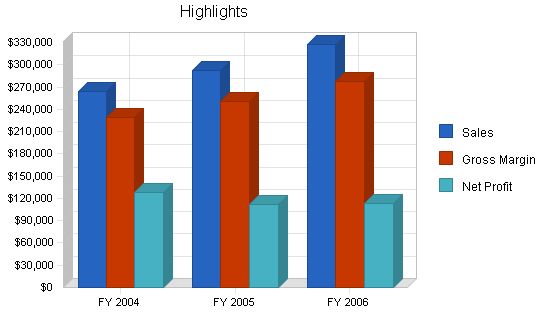
1.1 Keys to Success
A well-targeted marketing plan utilizing modern technologies and traditional formats.
Providing a quality facility that is attractive to clients.
Delivering the quality of service that our marketing and facility images promise. Ereidi Farm has built its reputation by exceeding client expectations. Our attention to detail and commitment to clients remains unsurpassed.
1.2 Mission
The purpose of Ereidi Farm is to increase clients’ opportunities for successful thoroughbred investment by providing world-class quality, individualized care, and training programs at a safe facility staffed by caring, experienced personnel. Everyone at Ereidi Farm has a deep commitment to clients. We believe that constant communication, unquestionable integrity, and our ability to provide "Full Circle" services are the hallmarks of our success and growth.
1.3 Objectives
Secure financing to purchase a turn-key facility located in a developing area. The facility must represent real value, selling for less than its cost to build and having a location targeted for long-term growth and development, thus increasing the value of the land. The land parcel must be suitable for other uses than farming to provide long-term development options. Interstate access, both locally and regionally, must be excellent. The land must be located in an area with required support structures suitable for a horse farm.
Ereidi Farm, Inc. is a subchapter S corporation (incorporation is in progress) located in Schwenksville, Pennsylvania. Ereidi Farm began as a part-time business when its owner’s only child was a toddler. The owner has worked within the horse industry for over twenty years, and the farm’s services are in high demand.
Due to changes in Pennsylvania’s thoroughbred racing program, the demand for quality services has escalated. After the planned purchase of our new facility is complete, we will relocate to Pine Grove, Pennsylvania. The farm offers exceptional "Full Circle" services to thoroughbred owners and breeders. Our specialty is highly individualized training and care programs with a strong focus on client communications and education. We are committed to the success of our clients’ thoroughbred investments and go above and beyond to secure the best opportunities for our clients and their horses.
2.1 Company Ownership
Ereidi Farm was formed as a sole proprietorship by its owner, Heidi Trimbur. Current growth patterns have made it prudent to incorporate, and its new subchapter S corporation status is pending. The business remains a private entity, held by its owner.
2.2 Company History
The owner of Ereidi Farm has worked within the equine industry for over 20 years and is formally educated in equine science and management. Ereidi Farm was officially formed as a thoroughbred facility three years ago. The farm, despite being a part-time venture at startup, held close to the break-even point in its first year.
Second year sales were directly affected by the events of September 11, 2001, as the Fall yearling thoroughbred sales began on September 10th of that year. Despite this loss, Ereidi Farm came back strong in 2002, generating a profit. Sales have been profitable in 2003, with the farm’s largest sales quarter in the Fall.
The need for expansion has become obvious as the farm has had to turn clients away due to lack of space. With the pending growth of Pennsylvania’s thoroughbred industry, expansion strategy and timing have become top priorities.
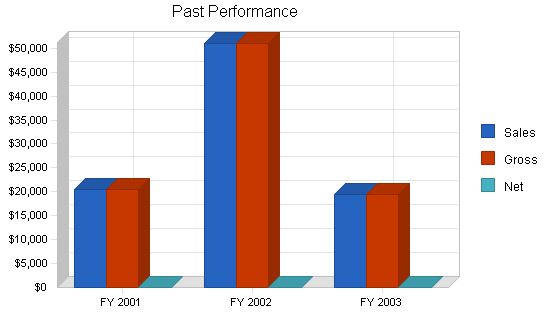
Ereidi Farm specializes in providing personalized services to the thoroughbred racehorse industry. These include breaking and training of youngsters, broodmare management and foaling, boarding for youngsters, and post-operative rehabilitative service for recovering racehorses. The farm also breeds and sells quality Pennsylvania-bred foals and offers consulting and genetic services for those new to the industry.
The largest market segment for Ereidi Farm will be owners of quality thoroughbreds who do not reside in Pennsylvania. Racing purses and breeding fund monies have been declining in traditionally strong racing states, prompting owners to search for more profitable venues. Pennsylvania, with its anticipated growth in purse and bonus monies, has become an attractive option for owners looking for more lucrative markets.
This trend is supported by statistical data. Pennsylvania has increased its U.S. Foal Crop share (2.7%) and is now among the top ten producing states. The average stallion book size has also increased, placing Pennsylvania in the top ten for stallion book size. Conversely, states like California, Texas, Maryland, Oklahoma, and Illinois have seen declines in their racing programs. Ereidi Farm has received requests for boarding and foaling services from residents of Maryland and New Jersey, indicating their need to relocate their thoroughbred operations.
Research shows that today’s thoroughbred owners are primarily male, although female investors are on the rise. The average age of owners is 45+, and many are pooling their resources and forming partnerships. They have an income exceeding $90,500 per year and take a business approach to thoroughbred investing. Quality is their focus, and they are willing to pay for better services. Over 80% of owners utilize the Internet for research.
Pennsylvania presents a great opportunity for new or migrating investors due to its historical position in thoroughbred production and racing, which has been associated with "low-end" quality. This makes Pennsylvania an attractive option for those with quality bloodstock programs and those who can offer superior facilities and services.
Ereidi Farm has targeted two specific markets for its growth strategy. The first is potential clients currently breeding and racing their horses in states with declining racing and breeding programs. These clients are looking to relocate and are accustomed to higher expenditures per horse compared to traditional Pennsylvania thoroughbred owners. States like California, Texas, Louisiana, Maryland, Oklahoma, Illinois, New Jersey, and Virginia have experienced declining Foal Crop shares, reflecting the overall condition of their racing programs. Ereidi Farm has specifically targeted thoroughbred owners in these states.
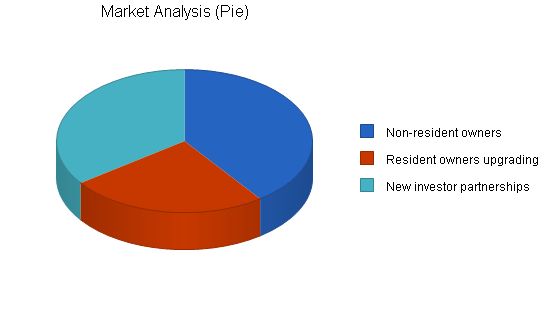
| Market Analysis | |||||||
| 2003 | 2004 | 2005 | 2006 | 2007 | CAGR | ||
| Potential Customers | Growth | CAGR | |||||
| Non-resident owners | 65% | 56,211 | 92,748 | 153,034 | 252,506 | 416,635 | 65.00% |
| Resident owners upgrading | 32% | 35,132 | 46,374 | 61,214 | 80,802 | 106,659 | 32.00% |
| New investor partnerships | 26% | 49,185 | 61,973 | 78,086 | 98,388 | 123,969 | 26.00% |
| Total | 46.50% | 140,528 | 201,095 | 292,334 | 431,696 | 647,263 | 46.50% |
4.2 Target Market Segment Strategy
Ereidi Farm provides high-end quality and service within our industry. Therefore, it is imperative that we define, locate, and attract clients with the necessary funds to purchase our services. Understanding the historical flow of regional racing is important for client recruiting.
The better regional racing stables traditionally raced on the New York, New Jersey, and Maryland circuit. Horses that couldn’t win in these states were shipped to the "low-end" racing circuits of Pennsylvania and West Virginia, where purse sizes were smaller. Since horses in these "low-end" states didn’t earn as much money, their owners couldn’t afford higher prices for services. As a result, most Pennsylvania farms focus on price rather than quality and rely on quantity to meet their quotas.
As our standards for care are different from traditional Pennsylvania farms, it was important to define and locate clients who fit our "ideal client" profile. Our clients are well-educated professionals who use the Internet to stay up to date with industry changes and trends. They expect outstanding service and are willing to pay for it.
Upon securing financing for our expansion, Ereidi Farm is prepared to launch its marketing campaign. We will target our client base through Internet advertising, our website, print advertising in selected magazines and national newspapers, industry sales seminars and trade shows, business-to-business contacts, organizational memberships, and open houses at our facility.
4.3 Service Business Analysis
The thoroughbred industry in the United States is the largest in the world, offering 55,127 yearly races (2001). Japan is ranked second with 23,820 races and Australia third with 21,218 races. Thoroughbred racing as entertainment is growing. Pari-mutuel handle on thoroughbred racing in the United States exceeded $15 billion for the first time in 2002. This marked the ninth consecutive year of growth in handle.
U.S. purses advanced 0.6% in 2002 to $1,074,247,738. The bulk of the increase came from tracks in Delaware, Louisiana, New Mexico, and West Virginia, which offer expanded forms of gaming. Pennsylvania will join this list upon passing slot machine legislation, increasing its purse sizes and number of thoroughbreds racing for the increased purse offerings.
In addition to purse offerings, owners and breeders have another source of income from the Pennsylvania Horse Breeders Association’s Breeding Fund Program. This program distributes more money per foal than nearly every other state-bred program. Qualifying for these residual income awards requires the horse to be a registered Pennsylvania-bred foal. The demand for quality foaling and boarding facilities within the state has increased as a result.
Pennsylvania racing is poised for lucrative and dramatic growth as smart investors position themselves to capitalize on the new purse structure provided by slot machines. This has already caused a shortage of stall space at tracks and farms throughout the state, as well as increased demand for quality services and programs.
Ereidi Farm recognizes the time-critical nature of entering any expanding market. Our strategy is to complete our relocation prior to the expected growth, allowing us to better provide the services desired by incoming owners.
4.3.1 Competition and Buying Patterns
Pennsylvania has many small farms that prioritize price. These farms were created to service traditional Pennsylvania thoroughbred owners. Our farm, however, focuses on exceptional quality care and outstanding customer service.
A few large farms in Pennsylvania attempt to market themselves as full-service facilities and target our intended client base. These farms include Pin Oak Stud, Xanthus Farm, Reigle Heir Farm, Castle Rock Farm, and Swatara Farm. Of these, only Pin Oak Stud positions itself as a full-service facility, while the others focus on the stallion and breeding market.
Our clients frequently express satisfaction with the care their horses receive at Ereidi Farm. They appreciate the quality of our programs and our strong emphasis on building a positive business relationship. Price is not a major concern for our clientele, as they understand the cost of delivering world-class care and service. Quality and service are the key factors they consider when deciding where to send their horses.
Strategy and Implementation Summary
Ereidi Farm will focus its expansion on the following markets: thoroughbred owners and breeders in state racing programs that are in decline, Pennsylvania thoroughbred owners and breeders looking to upgrade their stock, and new potential first-time owners, usually in the form of partnerships.
Attracting these clients will be done using modern technology, such as internet advertising and our website, as well as targeted print advertising. We will also increase our presence at public venues where our potential clients gather, such as thoroughbred sales, seminars, racetracks, and trade shows.
Our farm has built a reputation for exceeding clients’ expectations in horse care and customer service. These qualities will continue to be the hallmarks of Ereidi Farm.
5.1 Competitive Edge
Ereidi Farm’s competitive advantage is multi-faceted. We differentiate ourselves from our competitors in the following ways:
- Our people: We invest in quality, client-focused individuals and provide them with opportunities for continued learning and skill utilization. Our people are well-informed, engaging, and embrace the Ereidi Farm "Full Circle" service philosophy.
To develop effective business strategies, perform a SWOT analysis of your business. Learn how to perform a SWOT analysis with our free guide and template.
5.2 Sales Strategy
Our marketing programs are designed to create a desire for potential clients to contact us and schedule a visit to our farm. Visual inspection of our facilities, personnel, and horses in training plays a crucial role in closing sales within our industry.
Our sales strategy revolves around providing clients with an immaculate, safe facility staffed by knowledgeable, service-oriented individuals. We allow inspections during training hours and always welcome our clients. Along with outstanding references and recorded results, these details make closing the sale at a profitable margin possible and pleasant for all parties involved.
5.2.1 Sales Forecast
Sales forecasting is based on the yearly cycle of demand for each particular service. Training requests will increase as the Fall months arrive and grow steadily into Winter. Broodmare services will begin to climb as Winter approaches and the foaling season begins. Boarding of weanlings, yearlings, and rehabilitative horses will start to grow as Fall months commence.
Our home-grown sales always occur during the Fall months, which is when the market actively seeks to buy. The dramatic rise in sales reflects our facility’s expansion. Our current facility cannot accommodate a large number of horses, but with the expansion, we will gain more market share and make our services available to a larger group of clients.
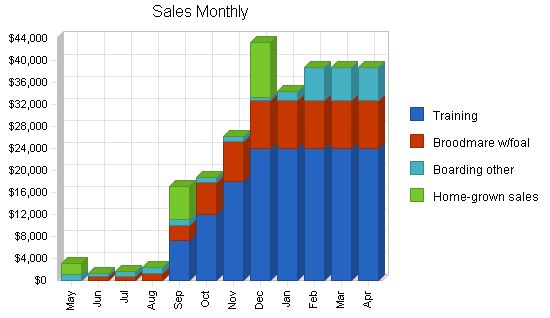
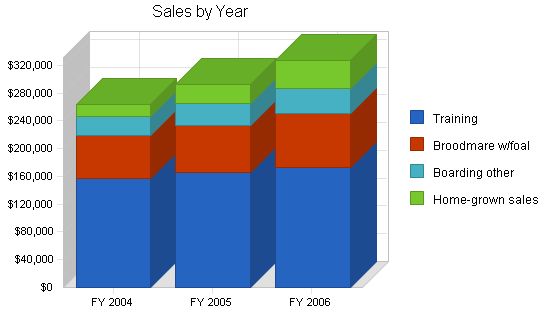
Sales
– Training: $157,200 (FY 2004), $165,060 (FY 2005), $173,313 (FY 2006)
– Broodmare w/foal: $61,680 (FY 2004), $69,082 (FY 2005), $77,371 (FY 2006)
– Boarding other: $27,370 (FY 2004), $31,476 (FY 2005), $36,197 (FY 2006)
– Home-grown sales: $18,000 (FY 2004), $27,000 (FY 2005), $40,500 (FY 2006)
– Total Sales: $264,250 (FY 2004), $292,617 (FY 2005), $327,381 (FY 2006)
Direct Cost of Sales:
Training: $13,100 (FY 2004), $13,755 (FY 2005), $14,443 (FY 2006)
Broodmare w/foal: $8,500 (FY 2004), $9,520 (FY 2005), $10,662 (FY 2006)
Boarding other: $5,400 (FY 2004), $6,210 (FY 2005), $7,142 (FY 2006)
Home-grown sales: $8,000 (FY 2004), $12,000 (FY 2005), $18,000 (FY 2006)
Subtotal Direct Cost of Sales: $35,000 (FY 2004), $41,485 (FY 2005), $50,247 (FY 2006)
5.3 Marketing Strategy:
Our top marketing strategy is an ecstatic client! Ereidi Farm’s owner has extensive experience in developing marketing and direct mail campaigns, editing communications, and utilizing technology. Our target market consists primarily of Thoroughbred owners and breeders outside of Pennsylvania, currently in deteriorating state racing/breeding programs; Pennsylvania Thoroughbred owners and breeders who realize they must upgrade their programs to remain competitive in the changing market; new investors in the Thoroughbred industry working within partnerships to minimize cost and risk while achieving a set quality level.
We will rely on technology to generate awareness of our expansion by utilizing the Internet to reach potential clients who are known Internet users. Our farm utilizes digital imaging, which has been the number one reason for our increased sales in the past year. We have identified specific Internet sites to advertise our expansion and maintain our own website.
We are building an email mailing list for mass marketing at high speed. Selected print publications have been targeted to reach those in deteriorating racing states and potential new investors. We will increase our presence at industry sales, seminars, and trade shows, continue to expand our business-to-business network, and provide open houses for interested individuals to visit our farm.
5.4 Milestones:
The accompanying table lists important program milestones, their dates, managers in charge, and budgets. The milestone schedule highlights our emphasis on implementation planning.
What the table doesn’t show is the commitment behind it. Our business plan includes complete provisions for plan-vs.-actual analysis, and we will hold monthly follow-up meetings to discuss variances and course corrections.
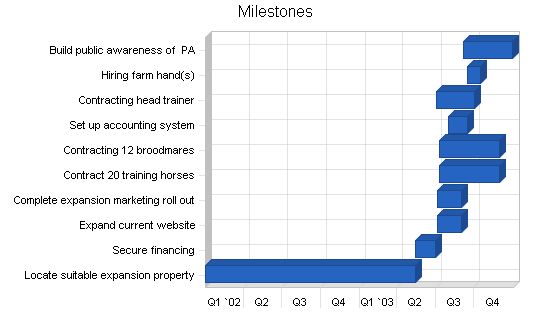
Milestones:
Milestone Start Date End Date Budget Manager Department
Locate suitable expansion property 1/1/2002 5/15/2003 $1,500,000 ABC Marketing
Secure financing 5/15/2003 6/30/2003 $22,000 Eric & Heidi Accounting
Expand current website 7/5/2003 8/31/2003 $0 Heidi Trimbur Marketing
Complete expansion marketing roll out 7/5/2003 8/31/2003 $1,000 Heidi Trimbur Marketing
Contract 20 training horses 7/10/2003 12/1/2003 $0 Heidi Trimbur Marketing
Contracting 12 broodmares 7/10/2003 12/1/2003 $0 Heidi Trimbur Marketing
Set up accounting system 8/1/2003 9/15/2003 $0 Eric Trimbur Accounting
Contracting head trainer 7/4/2003 10/1/2003 $0 Heidi Trimbur Admin
Hiring farm hand(s) 9/15/2003 10/15/2003 $150 Eric Trimbur Admin
Build public awareness of PA 9/5/2003 12/31/2003 $1,000 Eric & Heidi Marketing
Totals $1,524,150
Web Plan Summary:
The owner of Ereidi Farm built and maintains the farm’s website. The site provides an Internet presence that represents the farm through images and text. Our farm site provides actual images of the horses in our care and gives a visual comparison when shopping for services.
The text allows us to share our philosophy on horse care and condition. Ereidi Farm has attracted new clients through its website. Construction was done with ease of use in mind. We plan to add digital video to the site in early fall of 2003. Our Web address is: www.ereidifarm.net – Welcome!
6.1 Website Marketing Strategy:
As our expansion occurs, the search engines and direct links to our site from targeted sites will be reviewed and updated. Viewers’ addresses will be utilized for our e-mail direct mail list. All print advertising and communications will feature the Web address.
Management Summary:
The current management team consists of the owner and her husband. As expansion occurs, we will expand our personnel as required, starting with a training manager. Management opportunities in various areas will be expanded as growth continues, including broodmare, young stock, financial, and maintenance areas. The owner will maintain contact with all horses and clients.
7.1 Personnel Plan:
The Personnel table indicates the number of employees required during the initial expansion. Additional employees that will be added during the expansion phase include grooms, exercise riders, maintenance workers, broodmare specialists, and office workers. A stallion manager and skilled stallion grooms will be long-term additions.
Ereidi Farm intends to grow its cash profits by expanding to a larger turn-key facility. A turn-key facility allows immediate cash flow at the higher end of the market. Our farm sells a service and does not maintain an inventory. We operate on a “Cash Only” basis and choose our clients accordingly. At this time, the owner’s husband supplies additional capital as needed.
8.1 Important Assumptions:
Important assumptions concerning the thoroughbred market and Ereidi Farm’s targeted market include:
– The thoroughbred market industry in Pennsylvania will continue to grow.
– Statistics will continue to indicate the decline of racing programs in traditionally strong racing states.
– New owners will invest in the industry.
– Our targeted markets will continue to post personal income growth.
8.2 Break-even Analysis:
Break-even assumptions are as follows:
1. Per unit cost is based on one horse with a total start-up units of 33 horses.
2. Variable costs include salaries, advertising, maintenance, and office expenses.
3. Fixed costs include mortgage/loan, taxes, insurance, utilities, and the cost to keep 33 horses.
Break-even calculations are shown in the following table and chart.
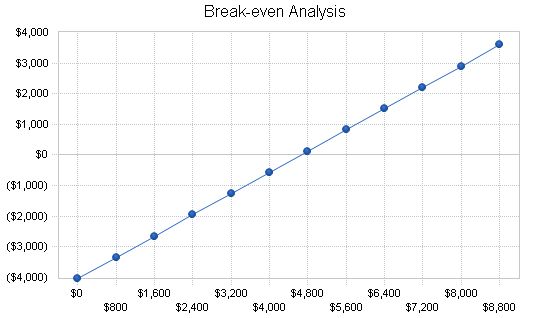
Break-even Analysis
Monthly Revenue Break-even: $4,652
Assumptions:
Average Percent Variable Cost: 13%
Estimated Monthly Fixed Cost: $4,036
Projected Profit and Loss
Our planned expansion generates a profit after deducting total expenses from gross profit. As growth happens, expenses increase, but our net profit also rises. This mirrors the standard cost of doing business in the horse industry.
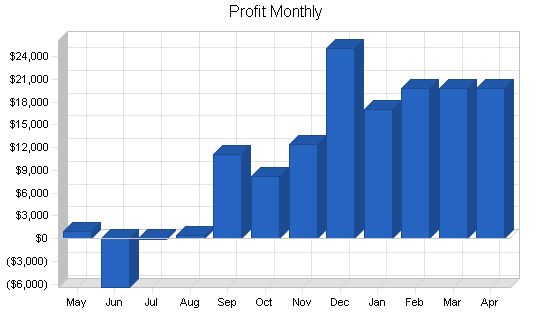
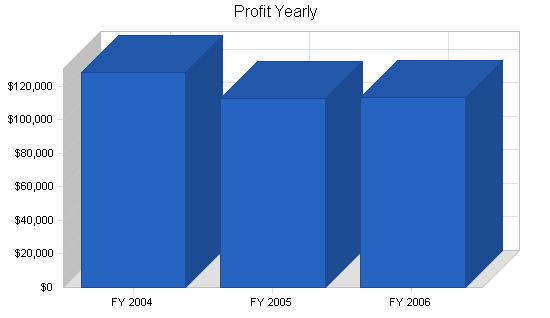
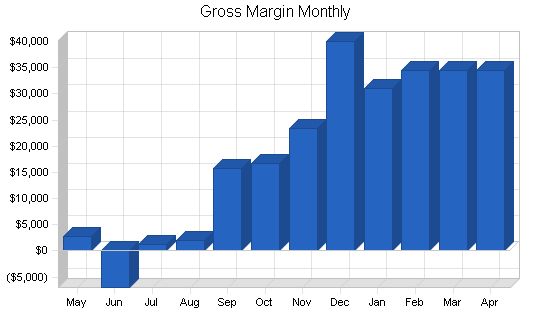
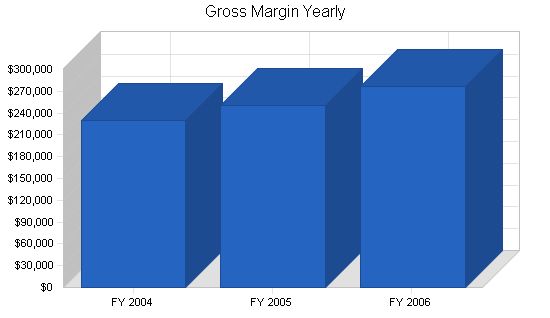
Pro Forma Profit and Loss:
| Pro Forma Profit and Loss | |||
| FY 2004 | FY 2005 | FY 2006 | |
| Sales | $264,250 | $292,617 | $327,381 |
| Direct Cost of Sales | $35,000 | $41,485 | $50,247 |
| Other Costs of Sales | $0 | $0 | $0 |
| Total Cost of Sales | $35,000 | $41,485 | $50,247 |
| Gross Margin | $229,250 | $251,132 | $277,135 |
| Gross Margin % | 86.75% | 85.82% | 84.65% |
| Expenses | |||
| Payroll | $40,030 | $76,872 | $97,800 |
| Sales and Marketing and Other Expenses | $0 | $0 | $0 |
| Depreciation | $2,400 | $2,400 | $2,400 |
| Rent | $0 | $0 | $0 |
| Payroll Taxes | $6,005 | $11,531 | $14,670 |
| Other | $0 | $0 | $0 |
| Total Operating Expenses | $48,435 | $90,803 | $114,870 |
| Profit Before Interest and Taxes | $180,816 | $160,329 | $162,265 |
| EBITDA | $183,216 | $162,729 | $164,665 |
| Interest Expense | $14,274 | $14,290 | $14,274 |
| Taxes Incurred | $38,402 | $33,589 | $34,901 |
| Net Profit | $128,140 | $112,450 | $113,090 |
| Net Profit/Sales | 48.49% | 38.43% | 34.54% |
8.4 Projected Cash Flow
Ereidi Farm operates as a "Cash Only" business to increase cash flow and limit liabilities. While we do accept payments for the horses we sell, the rest of our transactions are conducted in cash.
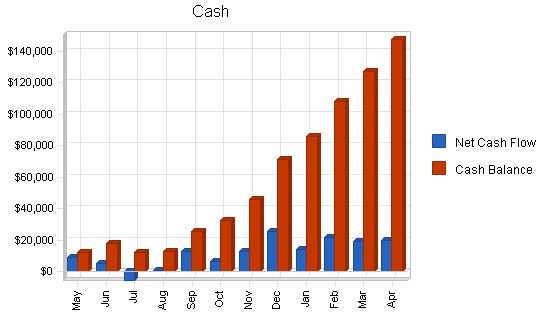
Pro Forma Cash Flow:
| Pro Forma Cash Flow | |||
| FY 2004 | FY 2005 | FY 2006 | |
| Cash Received | |||
| Cash from Operations | |||
| Cash Sales | $224,613 | $248,725 | $278,274 |
| Cash from Receivables | $41,176 | $42,669 | $47,608 |
| Subtotal Cash from Operations | $265,788 | $291,393 | $325,882 |
| Additional Cash Received | |||
| Sales Tax, VAT, HST/GST Received | $0 | $0 | $0 |
| New Current Borrowing | $0 | $0 | $0 |
| New Other Liabilities (interest-free) | $0 | $0 | $0 |
| New Long-term Liabilities | $0 | $0 | $0 |
| Sales of Other Current Assets | $0 | $0 | $0 |
| Sales of Long-term Assets | $0 | $0 | $0 |
| New Investment Received | $0 | $0 | $0 |
| Subtotal Cash Received | $265,788 | $291,393 | $325,882 |
| Expenditures | FY 2004 | FY 2005 | FY 2006 |
| Expenditures from Operations | |||
| Cash Spending | $40,030 | $76,872 | $97,800 |
| Bill Payments | $81,830 | $104,452 | $113,007 |
| Subtotal Spent on Operations | $121,860 | $181,324 | $210,807 |
| Additional Cash Spent | |||
| Sales Tax, VAT, HST/GST Paid Out | $0 | $0 | $0 |
| Principal Repayment of Current Borrowing | $0 | $0 | $0 |
| Other Liabilities Principal Repayment | $0 | $0 | $0 |
| Long-term Liabilities Principal Repayment | $0 | $0 | $0 |
| Purchase Other Current Assets | $0 | $0 | $0 |
| Purchase Long-term Assets | $0 | $0 | $0 |
| Dividends | $0 | $0 | $0 |
| Subtotal Cash Spent | $121,860 | $181,324 | $210,807 |
| Net Cash Flow | $143,928 | $110,069 | $115,075 |
| Cash Balance | $147,210 | $257,280 | $372,354 |
8.5 Projected Balance Sheet:
The balance sheet in the following table shows sufficient growth of net worth and a healthy financial position. Monthly estimates are included in the appendix.
Please note that specific variable and fixed expense categories have intentionally been left blank as these expenses are already factored into our "cost-per-horse" expense.
| Pro Forma Balance Sheet | |||
| FY 2004 | FY 2005 | FY 2006 | |
| Assets | |||
| Current Assets | |||
| Cash | $147,210 | $257,280 | $372,354 |
| Accounts Receivable | $11,399 | $12,622 | $14,122 |
| Other Current Assets | $87,684 | $87,684 | $87,684 |
| Total Current Assets | $246,293 | $357,586 | $474,161 |
| Long-term Assets | |||
| Long-term Assets | $490,000 | $490,000 | $490,000 |
| Accumulated Depreciation | $5,200 | $7,600 | $10,000 |
| Total Long-term Assets | $484,800 | $482,400 | $480,000 |
| Total Assets | $731,093 | $839,986 | $954,161 |
| Liabilities and Capital | FY 2004 | FY 2005 | FY 2006 |
| Current Liabilities | |||
| Accounts Payable | $11,850 | $8,293 | $9,377 |
| Current Borrowing | $13,000 | $13,000 | $13,000 |
| Other Current Liabilities | $0 | $0 | $0 |
| Subtotal Current Liabilities | $24,850 | $21,293 | $22,377 |
| Long-term Liabilities | $193,000 | $193,000 | $193,000 |
| Total Liabilities | $217,850 | $214,293 | $215,377 |
| Paid-in Capital | $0 | $0 | $0 |
| Retained Earnings | $385,103 | $513,243 | $625,693 |
| Earnings | $128,140 | $112,450 | $113,090 |
| Total Capital | $513,243 | $625,693 | $738,783 |
| Total Liabilities and Capital | $731,093 | $839,986 | $954,161 |
| Net Worth | $513,243 | $625,693 | $738,783 |
8.6 Business Ratios:
Business ratios for the years of this plan are shown below. Industry profile ratios based on the Standard Industrial Classification (SIC) code 0752.0102, [Breeding services, horses: racing and non-racing], are shown for comparison.
